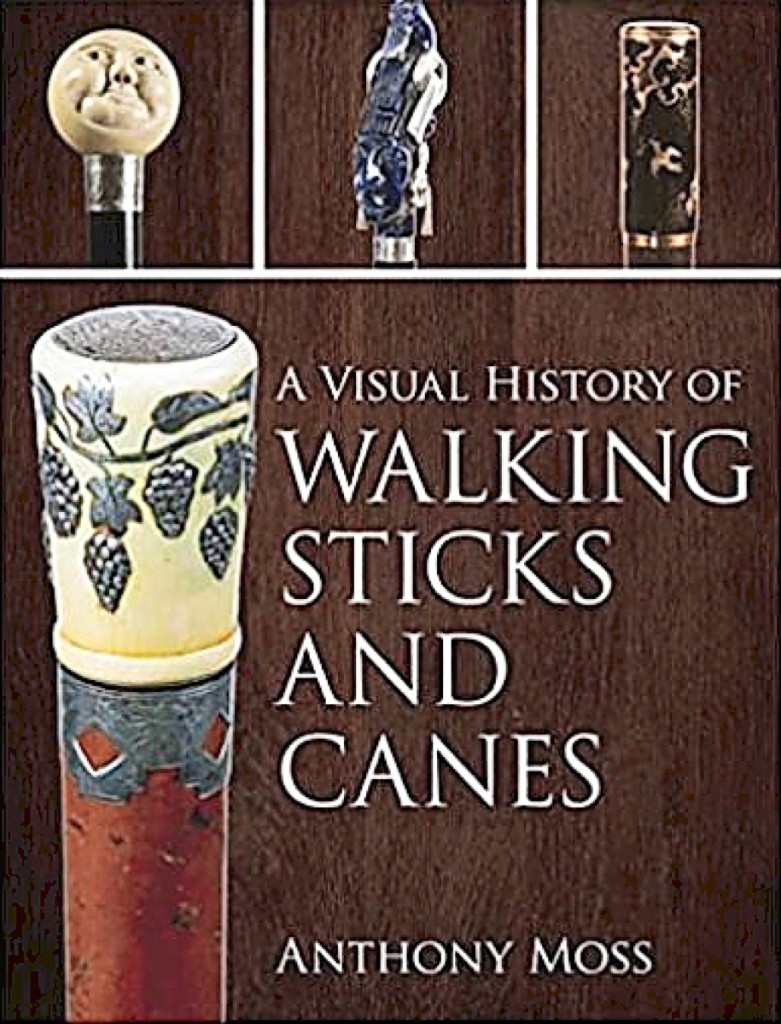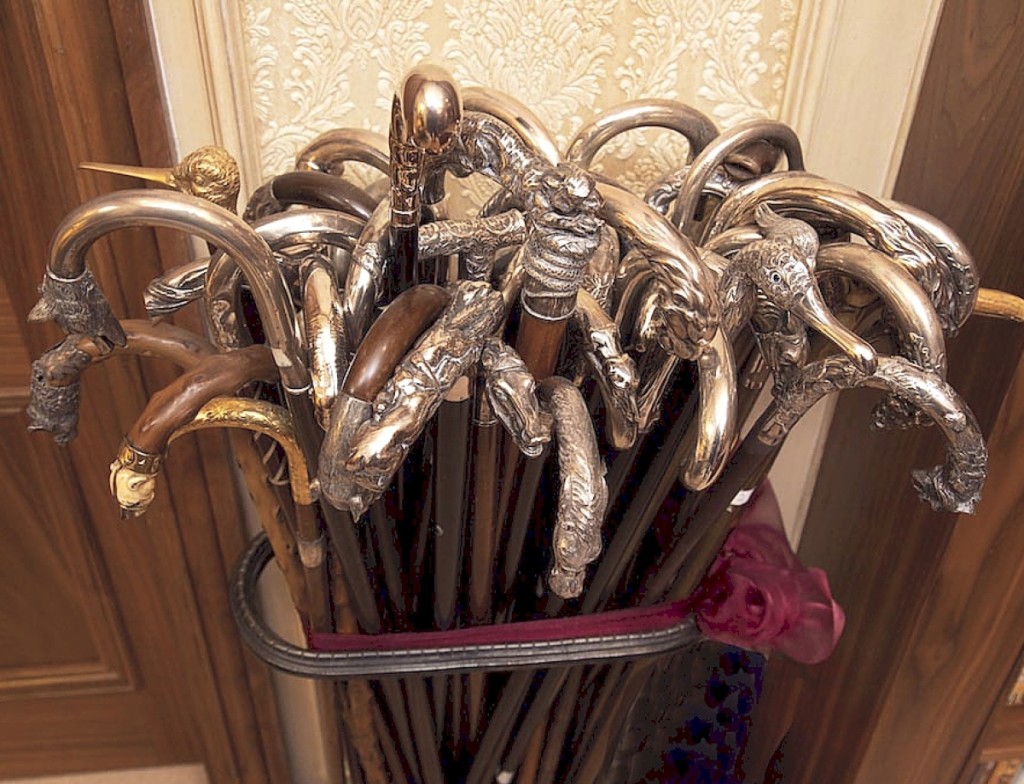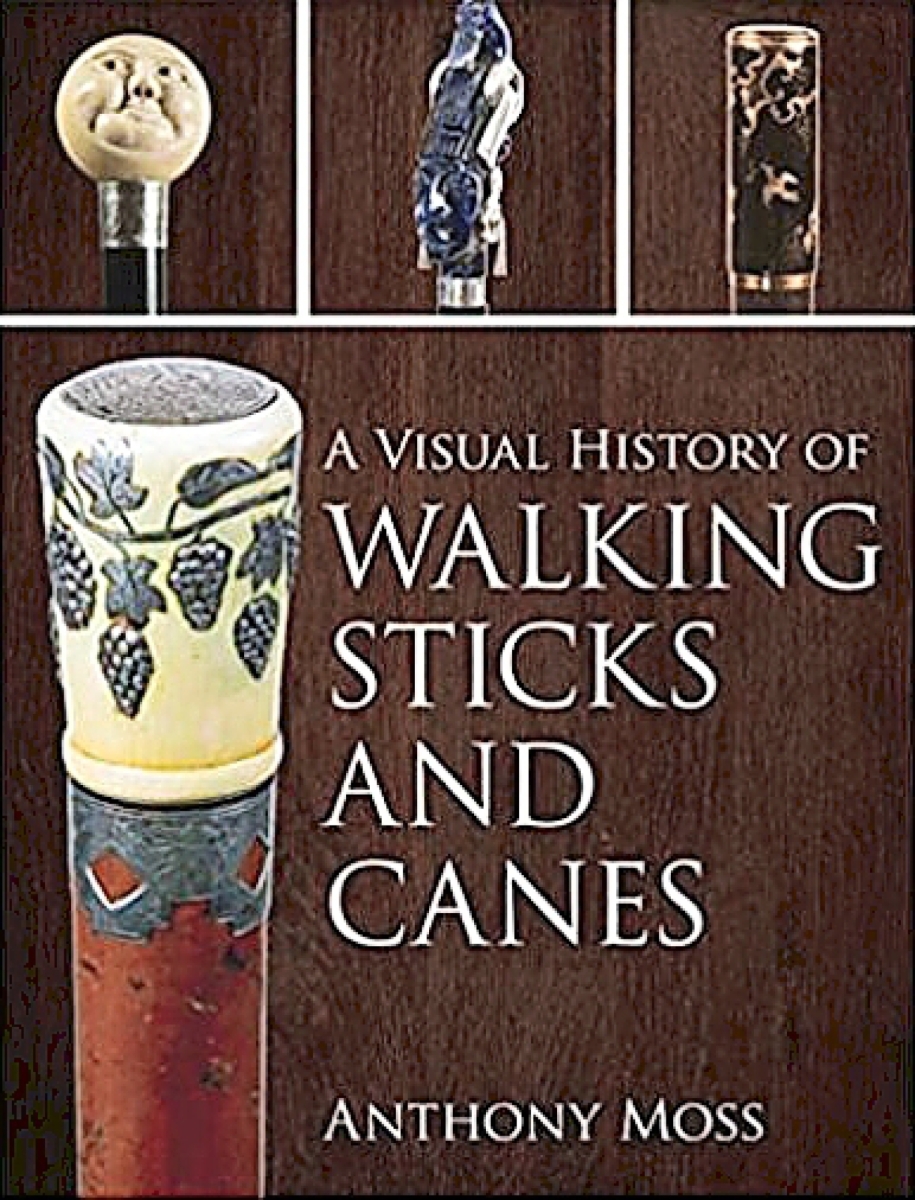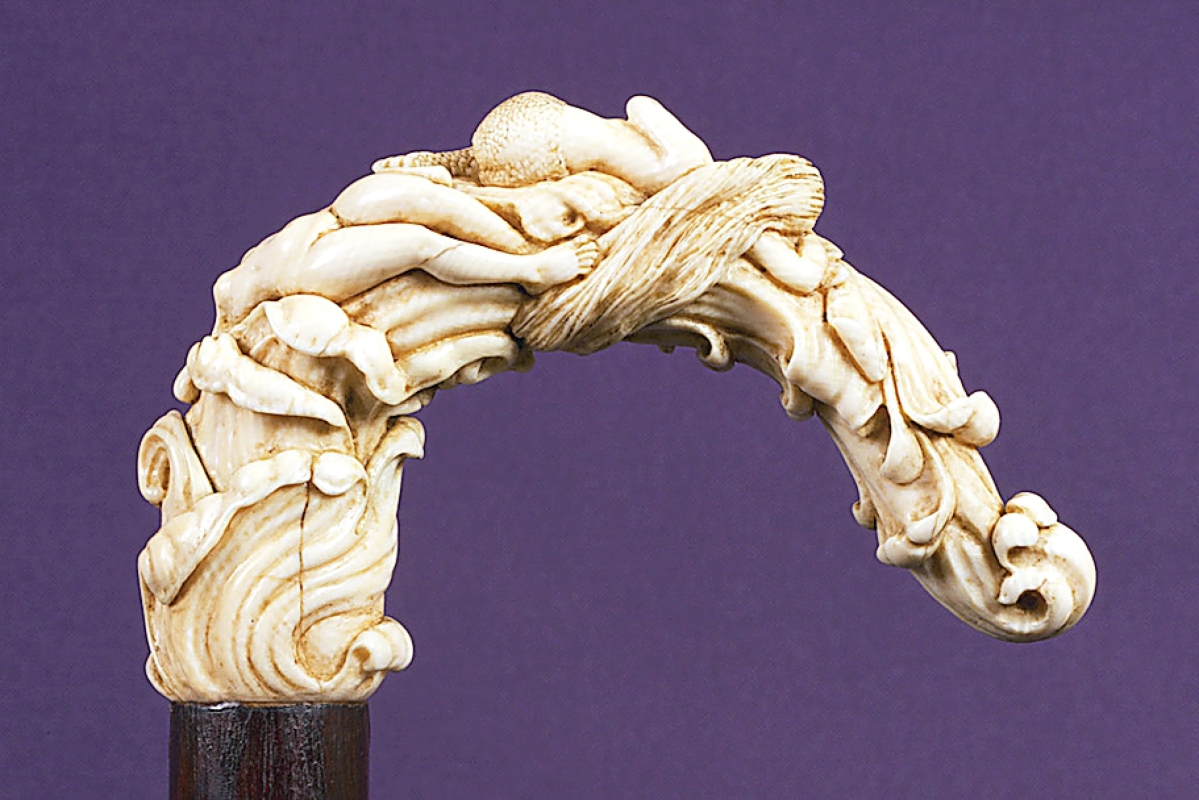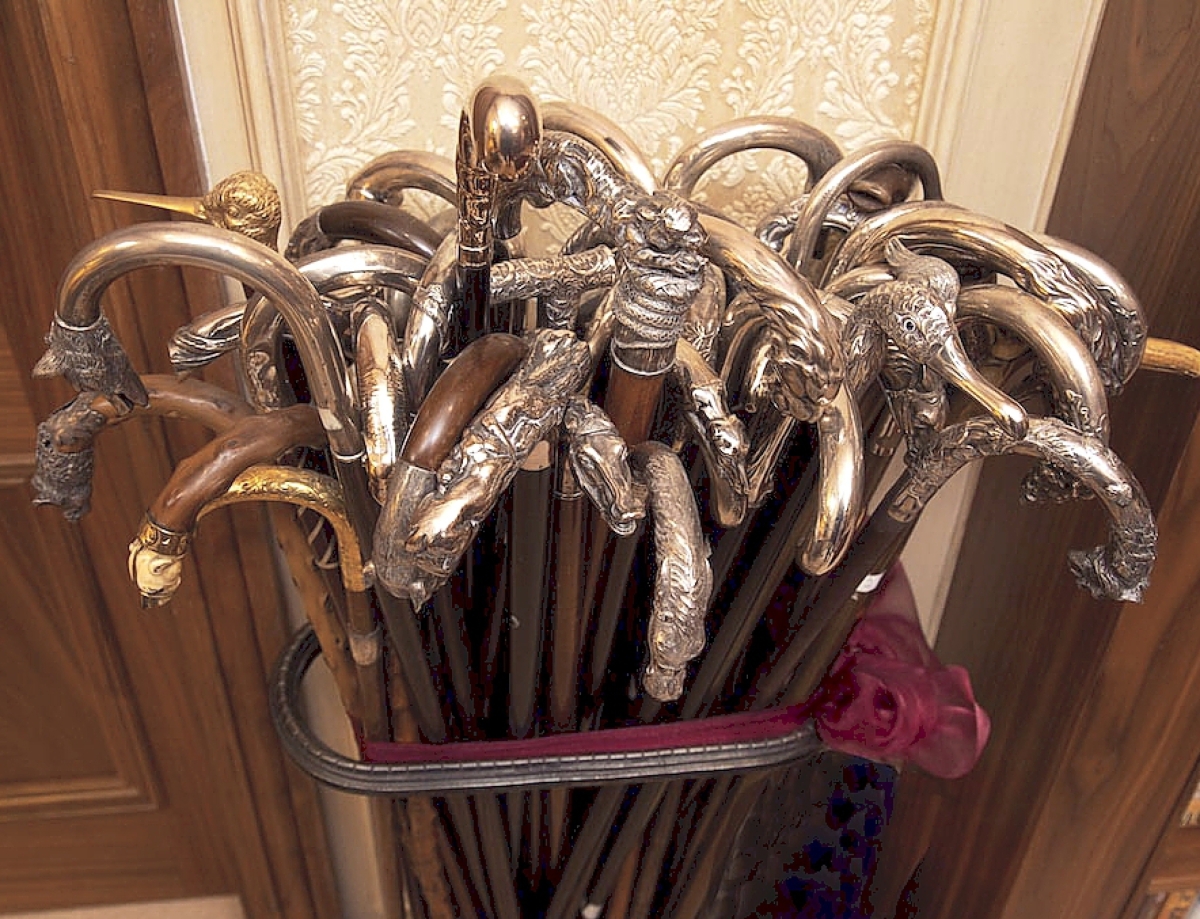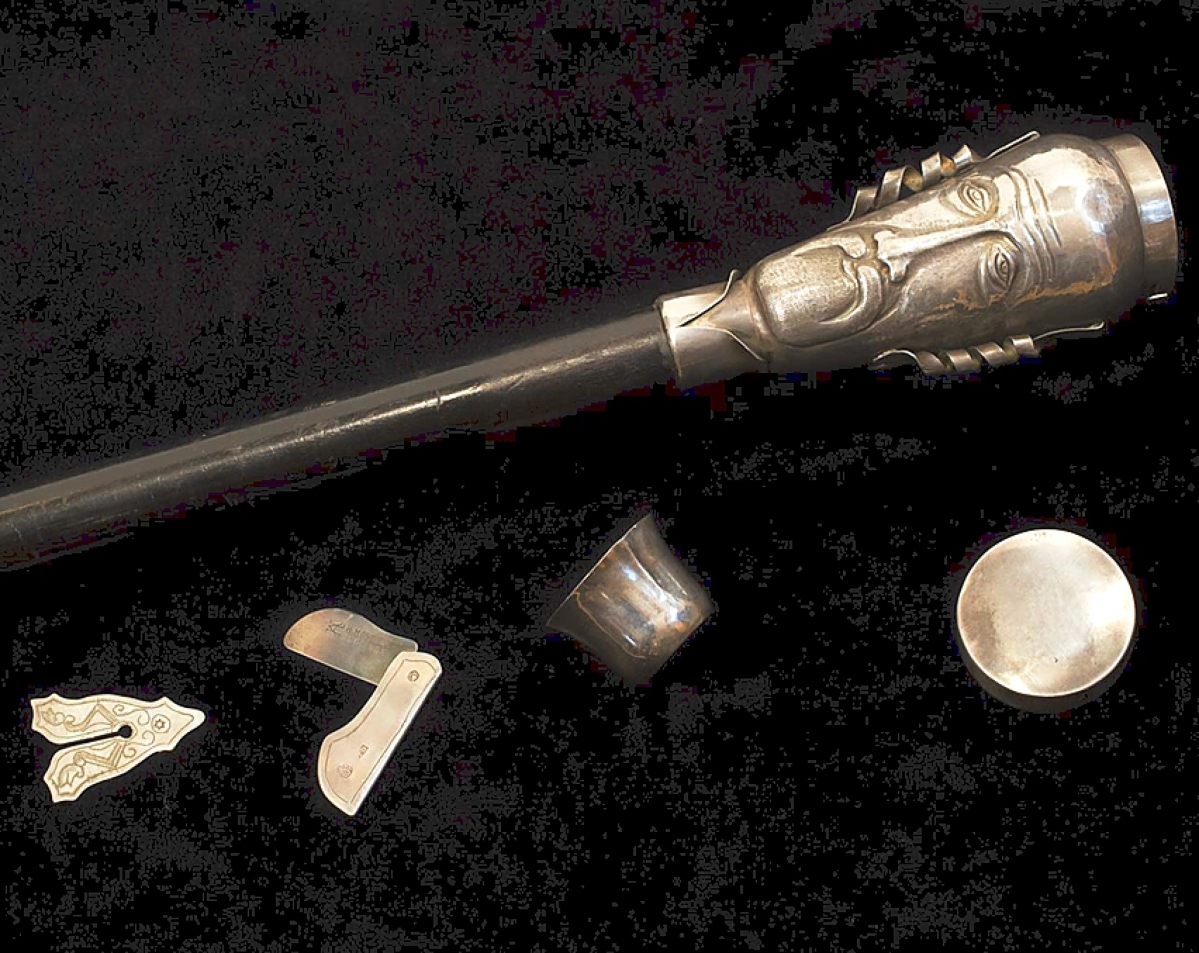Anthony Moss is “The Cane Guy,” or maybe more correctly a collector of walking sticks – a rabologist and joint chairman of the Antique Walking Cane Society, based in London. Moss is also a member of the International Society of Cane Collectors based in the United States and regularly attends Canemania – an international cane convention. He is the author of A Visual History of Walking Sticks and Canes, which he believes is perhaps the definitive guide to the world’s first fashion accessory. Antiques and The Arts Weekly sat down with Moss to better understand his passion for this collecting category that is embedded in the culture of almost every country in the world.
What set you down the path to collecting antique canes?
Collecting has always been my craving, starting at the tender age of 9, collecting books. Coming from an inherently poor family, they had little in the way of personal possessions, so when Deanna and I got married 57 years ago, we bought Victorian furniture as it was cheap. In the 1970s, our appetite expanded to encompass a wide range of antiques and collectibles. In 1998, Deanna made the mistake of buying me a few walking canes, and thus my passion as a rabologist began.
Rabologist?
Rabology is the English term for the scientific study of walking sticks (paboi, or ‘”rabdi,” the Greek for a stick or rod – “rabology” is already reserved for the study of logarithms, using rods as counters); the rabologist is a collector or student of walking sticks.
Deanna and I always imagined that we were antiques dealers. Over 50 years regularly, we made early morning calls to the fairs and markets, collecting items for our stock. We were passionate collectors, buying a wide range of smalls, from nutcrackers, treen, bronzes, whistles and counter bells and much more. The only way, whether as a dealer or collector, to gain knowledge is to handle items and talk to dealers. Yes, you make many mistakes and buy fakes, but that is the best way to learn your trade. This way, you build an appreciation of real quality, craftsmanship and gain experience.
How many walking sticks do you have and how are they stored or displayed?
There are currently about 2,600 walking canes in the A&D Antique Walking Cane Collection and more than 8,000 images. Deanna banned me from filling the house with walking canes, so I had to be selective, having a few on display around our house in stick stands. The solution, however drastic, was to add an extra floor to our house and create a new room with in-built plan chest draw units to house the canes. The drawers pull out to display the cane handles. Nevertheless, the collection is still growing and there is little space for more examples.
Can you give us an example of what you term a “narrative” cane?
The Mermaid cane is a significant example of a “narrative cane,” in which the handle is not merely a bust or purely decorative but instead represents a story. The handle is carved from a single piece of ivory with a superb patina and depicts a nude woman and a mermaid lying among a group of waves. The sculptor has expertly carved the woman’s sinuous hair and body to follow the curve of the handle, while her counterpart lies face up on the top of the handle, her exquisitely detailed tail wrapped around the swell. Ergonomic and aesthetically pleasing, the handle says a lot about its owner, its poetic subject lending an air of sensuality to this magnificent rosewood cane.
Similarly, the Memorial cane with various members of his family recording their births and deaths form a narrative as do some military canes recording notable battles along the cane’s shaft.
Gadget canes are the PT Barnums of the category. What are a few of your favorites?
There are several gadget canes that are in the circus category. Water-squirting canes, sometimes called “spitting sticks,” come with various shaped handles, adapted using a rubber or glass tube or a reservoir built into the cane shaft and activated by pressing a button on the shaft. Most seem to have been made in France.
They were used to store water, perfume or acid (vitriol) as a defensive weapon or were filled with water merely to tease children. Generally, a jet of water or liquid is emitted from the handle as a surprise.
Squirter canes were used as a communication device – perhaps to make people laugh, or to irritate others. They were made from a silver-colored white pot metal or even, possibly, Britannia metal, which was very inexpensive when first made or cast in the 1880s. Probably sold at street fairs.
The Brigg ivory-handled canes with an automaton cockatoo, donkey, dog or rabbit were carved by the Czilinsky family and mounted by Charles Cooke on a silver-gilt collar on a Malacca cane were straight out of PT Barnum tradition.
These novelty canes were very expensive, costing between 30 and 40 pounds, at the time. It can be assumed that these exclusive gadget canes with an automatic mechanism were bought to attract the attention of a lady, and it could be used to flirt or even amuse family and friends.
It is hard to choose a favorite because they are all so rare, but the automaton Cockatoo is the most glamorous and ingenious as when it is activated the plume or crest feathers suddenly and unexpectedly are raised and the beak opens.
What’s the oldest example in your collection?
The oldest canes in the collection are the English pique canes from the end of the Seventeenth Century and have dates inscribed. They are notable for their size and decoration, enjoying the distinction of having retained all their original parts and aged beautifully with the warm patina of more than 300 years of age. One is dated 1651. Nevertheless, the pilgrim canes may be older but it’s not possible to date them with any accuracy.
Some canes achieve notoriety. In Bob Dylan’s song “The Lonesome Death of Hattie Carroll,” he writes: “William Zanzinger killed poor Hattie Carroll/With a cane that he twirled around his diamond ring finger/At a Baltimore hotel society gath’rin’/And the cops were called in and his weapon took from him.” Do you know whatever happened to the cane?
I do not know what happened to the cane, but the cane used in the Brooks-Summer Affair is in a museum. The cane was commonly employed purely as an offensive or defensive weapon, but the most infamous early incident of violence involving a cane was no doubt the occasion involving Representative Preston Brooks, who used a cane made of gutta-percha to attack Senator Charles Sumner. The story has become known as the Brooks-Sumner Affair of May 22, 1856, occurring in the Senate chamber, when Brooks, a pro-slavery Democrat from South Carolina, used a walking cane to attack Sumner, an abolitionist Republican from Massachusetts.
Sting sings in his 1987 hit “Englishman in New York”: “See me walking down Fifth Avenue / a walking cane here at my side / I take it everywhere I walk.” The song was inspired by the dandy Quentin Crisp.
Speaking of dandies, antique canes seem mostly to be associated with gentlemen. Are there notable examples that were employed by females?
The Sixteenth Century saw the rise of women’s canes; these tended to be more delicate and were mainly made of ebony and decorated with mother-of-pearl. By the Seventeenth Century, fashion and taste were becoming increasingly important. In France, King Louis XIII (1610-1643) set the tone by dressing in a more sober style, carrying a very simple ebony can, with an ivory knop and no ornament.
Generally walking canes during the Eighteenth Century were for masculine apparel, used for posing, making a fashion statement and status. The walking cane pampered to masculine pursuits and vices – smoking, hunting, horse racing, loose women, drinking, smoking and gambling.
Towards the end of the Nineteenth Century, the gadget cane with additional functions became popular – a bit like the Swiss Army knife of today. Also called system sticks – they were not that elegant but curious and unrecognizable from the exterior as they concealed varieties of gadgets. Like pill boxes, pencils, corkscrews, snuff boxes, cigarette holders, ponce pots, nutmeg graters, lipsticks, powder compacts, scent bottles, lights, whisky bottles, knives, whistles, photo lockets, vinaigrette, watches, opera glasses and harmonicas.
Women did wear a cane as part of an outfit, but women and girls took a stick and covered it with fabric. It was then called a parasol or an umbrella. However, later women did carry a cane as a fashion item or one which might have been given to her, with a picture hidden in the handle by her loved one.
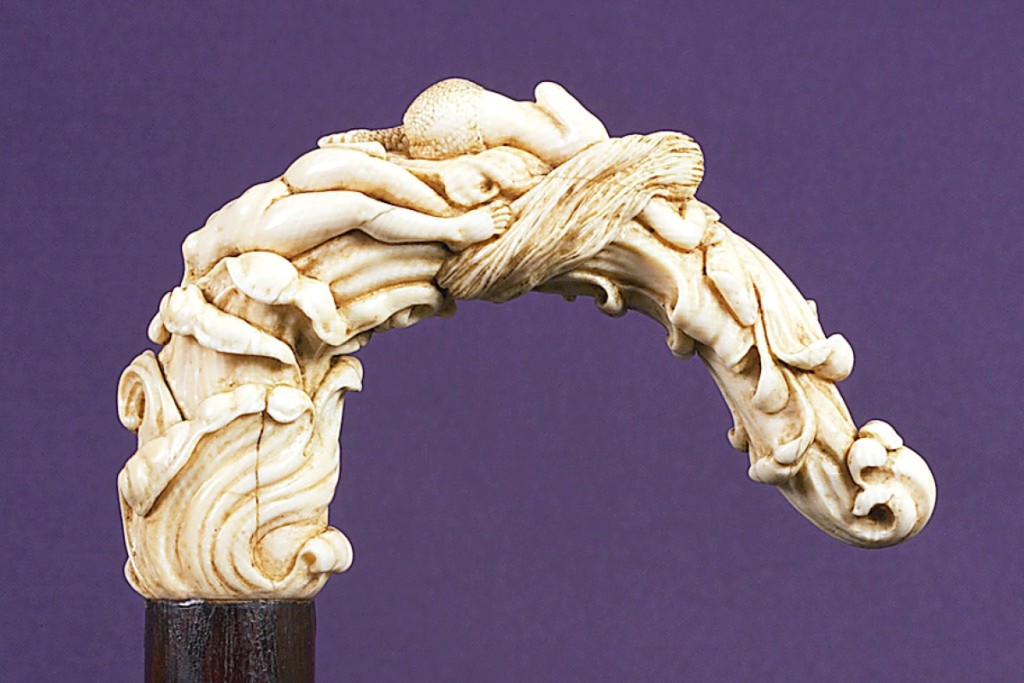
Cane with ivory mermaid handle, Germany, circa 1890, ivory handle, shaft with rosewood,
brass and ivory ferrule, 34 inches long.
Can you tell us about an example in your collection you termed “the ultimate tradesman’s cane”?
Professional or tradesman’s walking sticks indicate the occupation of the owner, whether by profession or trade. Perhaps a bailiff in legal service, a doctor by the entwined snakes of the caduceus, a rat catcher by a rat, a bishop by a mitre and so on.
The ultimate tradesman’s cane, a museum piece, in fact, is a silver mohel’s walking cane, with the hammered silver handle in the form of a rabbi’s head. The rabbi’s cap, known as kippah (headgear of male Jews), unscrews to reveal its contents: a silver circumcision bowl, circumcision knife and a brit milah shield, all marked with an A (the mark for Viennese 812/1000 silver), 1853 and TD (for Thomas Dub, a renowned Viennese silversmith). The knife is additionally marked “H. Moser er NCHF Solingen.”
In the Jewish faith, male circumcision is mandatory, representing a mark of the covenant made between God and the descendants of Abraham. In the Bible, the infant boy’s father is ordered to make the circumcision himself. Most fathers would not feel comfortable and do not have any training, so they employ a mohel. The mohel is trained to carry out and perform the rituals involved in the practice of circumcision. Most mohels are doctors, rabbis or cantors and receive suitable training in this medical and religious procedure.
How have you trained your eye to be able to spot a high-quality cane?
Initially, I had little idea what to collect and looked for craftsmanship and beauty. Over time, learning from dealers, I understood what was best to collect and therefore was selective. Later, I looked for rarity, artistry and missing examples to make the collection more representative of the range of walking canes produced over the centuries. This encompassed the Fifteenth Century up to the 1940s and then to the present day.
As you go around the antiques fairs, meet dealers and exchange views with collectors, your eye only sees walking canes.
How have the ivory trade restrictions affected your buying and selling?
The ban on the trade in the ivory tusks of the walrus, narwhal, mammoth and hippopotamus has not affected my affection for historic antique ivory pieces, and I refuse to believe that anyone will destroy pre-1947 antique ivory works of art. So my appetite is undiminished. Nevertheless, the UK Ivory Act 2018 appears to be coming into law in a few weeks and this will have an impact on the value and salability of some of my ivory-mounted canes and items. So far, it’s not illegal to own ivory pieces, and it is likely that there could be a trade between collectors. As an expert rabologist I might be able to certify items in my collection having provenance.
By the way, the US Ivory Ban does not limit the right to possess or pass down ivory to family members. Currently no state ivory ban limits the possession or inheritance of ivory, rhino horn or any of the wildlife products covered in the law. Therefore, residents are free to keep their ivory items, or pass them down to family members. California, however, bans the sale, or possession with intent to sell, even within the state.
Are the most desirable canes collected by European or American collectors or dealers?
Decorative canes, like those made by Fabergé, were a fashion accessory and both are the most desirable and generally the most expensive. Their function was purely beauty. The materials and designs used in these decorative fashion canes was only limited by the imagination of trained artisans and craftsmen. Ivory, gold, silver, porcelain, precious gemstones, enamel were just a few of the many materials employed in creating these smart decorative fashionable walking canes.
Tiffany & Co., the fine jewelry makers, commissioned master silversmiths and gem cutters to create canes and walking sticks for the American elite throughout the late Nineteenth Century and early Twentieth Century. Their walking canes are also very collectable and desirable.
Similarly, Brigg of London, the British cane and umbrella manufacturers during the Nineteenth Century, which had branches in a number of European capitals and sourced their elegant handles from international sources, is highly prized. Likewise, Howell & Co. of London, which was established in 1832 and employed upwards of 400-500 people in its London office, made some desirable and collectible canes.
Heritage Auctions in June 2012 sold one of the most expensive presentation canes for $95,000. Strangely, it was notable more for its shaft than its handle – the shaft being made from the last sleeper used in the completion the Transcontinental Railroad in 1869. Canes made of narwhal tusks are also some of the most expensive, refined and rare canes and also fetch high prices.
Where do they cross over into folk art?
Folk art canes are handmade and generally carved from one single piece of wood, cane or branch. Unlike the more formal or professionally made walking canes – even the early pilgrim and Black Forest canes were undoubtedly made by very skilled tradesmen. Many of these folk art canes were one-offs, fashioned by untrained artists. A number of these canes display magical or mystical symbols along the shaft, or feature patterns recounting an event of historical significance.
One such example are the alligator canes of America, which were made as tourist souvenirs. In the late Nineteenth Century, Florida was still a frontier, with large, unpopulated areas of land. The alligator motif adorned nearly every kind of tourist object produced. Similarly, the Prisoner of War canes must be considered folk art.
The cane – a practical necessity for navigating muddy, treacherous pre-modern streets or useful for fending off ruffians?
Besides being a fashion accessory, the canes worn in the courts offered much needed support to those indulging in the Georgian fashions of vertiginous wigs and high heels.
As Britain’s towns and cities expanded during the Eighteenth and Nineteenth Centuries, however, the emerging middle classes developed the pastime of walking, and canes began to take on a new role. Crammed into narrow streets, Londoners would empty chamber pots and rubbish bins straight out into the streets, which left passers-by navigating piles of human and animal waste at every turn.
Many roads and pavements were in a sorry state, as there was no drainage, so it was necessary to carry a strong walking cane with a long ferrule both for support on slippery surfaces and possibly even as a weapon of self-defense. There was no police force and no street lighting. In London in 1702 men were required to have a license to bear a cane.
What advice would you give a young collector?
The essential advice for a young collector is to buy quality, not quantity – a collection of 15 excellent walking canes is far better than a collection of rubbish. Also, please beware of the gadget walking canes as they are very often faked and created to deceive. So, unless the contents are practical or made as a presentation piece, it lets the buyer beware without some provenance. After a time, the collector can spot the genuine article.
Regarding your book, how do you believe it contributes to the scholarship and understanding of canes in culture?
I hope this book will inspire and interest new converts to the hobby of collecting canes and act, too, as a reference and catalog for existing collectors and dandies. The intention is to expand the subject by exploring how the walking cane, the parasol and the umbrella acquired their place in fashionable society and how they maintain their relevance even today.
The book brings to life a picture of a bygone era, a time when “the cane was king,” simulating an age which the only film, theater, literature and imagination can recreate. In this way, I wish to educate the student, collector, historian and researcher how the cane played such an essential role in fashion.
From the very start, through to the emergence of haute couture, through the Jazz Age and then through many years of austerity, culminating with World War II, the cane has held sway. Surprisingly, even today, the walking cane has retained its magic and is used in theater, fashion shows and by more flamboyant dressers or dandies.
-W.A. Demers
Where To Purchase The Book
A Visual History of Walking Sticks and Canes by Anthony Moss, ISBN-13: 978-1538144954 and ISBN-10: 1538144956I is available for $75 hardcover in North America:
https://www.amazon.com/Visual-History-Walking-Sticks-Canes/dp/1538144956
https://www.powells.com/book/a-visual-history-of-walking-sticks-and-canes-9781538144954
https://www.porchlightbooks.com/product/visual-history-of-walking-sticks-and-canes-anthony-moss


